| A | B |
|---|
| The movement of water molecules across a cell membrane is called ___. | osmosis |
| In a salt water solution, the salt is known as the ___. | solute |
| If a cell membrane allows glucose to pass through it, then the cell membrane is said to be ____ to glucose. | permeable, 
|
| In a salt water solution, the water is known as the ____. | solvent |
| The movement of particles across a cell membrane from areas of high concentration to areas of low concentration is known as ____. | diffusion,  |
| The cell membrane is said to be _______ permeable to substances because it lets some pass through but not others. | selectively |
| The type of substances that can most easily diffuse across a cell membrane are ____ substances. | small non-polar substances |
| The composition of nearly all cell membranes is a double-layered sheet called a __________ | lipid bilayer |
| Larger molecules and charged particles usually pass through _____ to get into cells. | protein channels |
| Cells will shrink if placed into a _____ solution. | hypertonic |
| When energy is needed to force molecules across a cell membrane, _______ is taking place. | active transport,  |
| Cells will grow bigger if placed in a ____ solution. | hypotonic |
When osmotic pressure increases in plant cells, why don't the cells usually burst?, 
| Plant cells have a tough cell wall that keeps the cell from expanding enough to burst. |
| If a solution is 6% solutes, it will be ____ % water. | 94 |
| If a solution is 90% water, it will have ___ % solutes. | 10 |
| A solution that has the same concentration of solutes as the interior of a cell is known to be ____. | isotonic |
| Active transport requires _____. | energy |
| If a substance is diffusing across a cell membrane, it is going from an area of ____ concentration to an area of ___ concentration. | high, low |
When osmotic pressure decreases in a plant, the ______ shrinks and the plant ____., 
| central vacuole, wilts |
| When osmotic pressure increases in plants, the ______ gets bigger and the plant ___. | central vacuole, gets turgid (stiff) |
| The type of cell membrane protein that allows larger molecules and ions to pass through by facilitated diffusion is called a ____. | channel protein |
The elodea cells in this picture are surrounded by a ______ solution.,  | hypotonic,  |
The process pictured below is called ____., 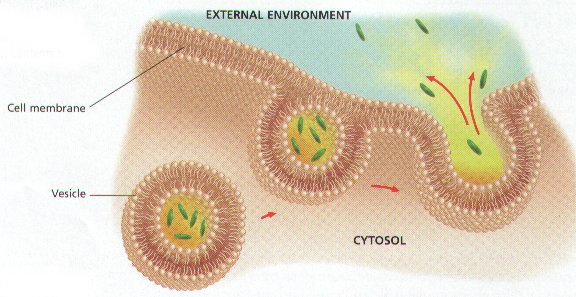 | exocytosis,  , , 
|
The elodea cells pictured below have been soaking in a ____ solution.,  | hypertonic,  |
| A type of protein that travels through the blood stream and attaches to receptor proteins on a cell's surface in order to deliver a chemical message is known as a ____. | hormone |
The process pictured below is called ____.,  | endocytosis,  , , 
|
| The type of endocytosis that takes in solid particles (usually food) is called ____. | phagocytosis |
| The type of endocytosis that takes in liquids is called ___. | pinocytosis |
| The type of endocyctosis in which the cell ingests extracellular fluid and its dissolved solutes is called _____. | pinocytosis |
| ______ is the cellular uptake of macromolecules and particulate substances by localized regions of the plasma membrane that surround the substance and pinch off to form intracellular vesicles. | endocytosis |
| In comparing two solutions, the one with the greater solute concentration is called the _____ solution. | hypertonic |
| _______ transport involves the diffusion of a substance across a biological membrane. | Passive transport |
| Passive transport involves the ______ of a substance across a biological membrane. | diffusion |
| The cellular secretion of macromolecules by the fusion of vesicles with the plasma membrane. | exocytosis,  |
| _______ involves the movement of a substance across a biological membrane against its concentration or electrochemical gradient with the help of energy input and specific transport proteins. | Active transport,  |
| A(n) ______ protein is typically a transmembrane protein with hydrophobic regions that completely span the hydrophobic interior of the membrane. | integral protein, 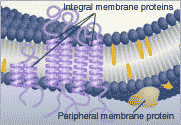 |
| A molecule that binds specifically to a receptor site of another molecule is called a(n) _____. | ligand |
| A molecule that has both a hydrophic region and a hydrophilic region is _____. | amphipathic |
| A protein channel in a cell membrane that allows passage of a specific ion down its concentration gradient is called a(n) _____. | ion channel |
| A property of biological membranes that allows some substances to cross more easily than others is called _____. | selective permeability |
| In comparing two solutions, the one with the lower solute concentration is called the _____ solution. | hypotonic |
| The currently accepted model of cell membrane structure, which envisions the membrane as a collage of individually inserted protein molecules drifting laterally in a fluid bilayer of phospholipids is called _____. | the fluid mosaic model, 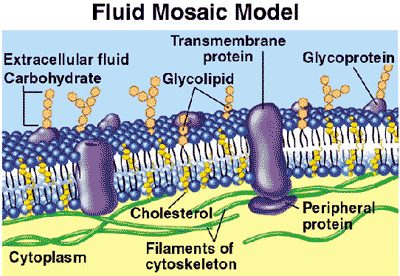 |
| A(n) ______ is a protein structure that involves active transport by using ATP to force hydrogen ions out of a cell, generating a membrane potential in the process. | proton pump (remember, a hydrogen ion is a proton), 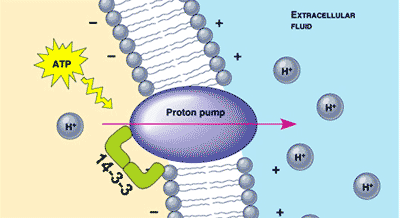 |
| A lipid covalently attached to a carbohydrate is called a(n) _____. | glycolipid (think of glycogen, which is a carbohydrate, attached to a lipid) |
| Another word to describe plants which are very firm due to the cells of the plant having a greater solute concentration than their surroundings is _____. | turgid |
| A special transport protein in the plasma membrane of animal cells that transports sodium out of the cell and potassium into the cell against their concentration gradients is called _____. | a sodium-potassium pump,  |
| The movement of specific molecules into a cell by the inward budding of membanous vesicles containing proteins with receptor sites specific to the molecules being taken in; enables a cell to acquire bulk quantities of specific substances. | receptor-mediated endocytosis, 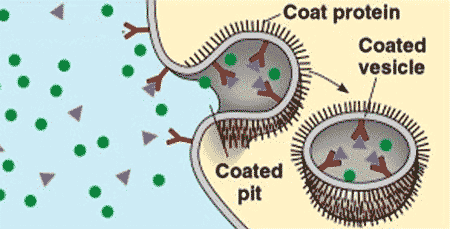 |
| The charge difference between a cell's cytoplasm and the extracellular fluid, due to a buildup of cations or anions on one side of the membrane. | membrane potential |
| A protein covalently attached to a carbohydrate is called _____. | a glycoprotein, 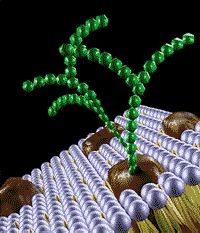 |
| The diffusion gradient of an ion, representing a type of potential energy that accounts for the concentration difference of the ion across a membrane and its tendency to move relative to the membrane potential. | electrochemical gradient,  |
| The coupling of the downhill diffusion of one substance to the uphill transport of another against its own concentration gradient. | cotransport |
| A protein channel in a cell membrane that opens or closes in response to a particular stimulus. | gated channel,  |
| The regulation of solute and water concentrations in body fluids by organisms living in hyperosmotic, hypo-osmotic, and terrestrial environments. | osmoregulation |
| A transport protein in the plasma membrane of a plant or animal cell that specifically facilitates the diffusion of water across the membrane (osmosis). | aquaporin, 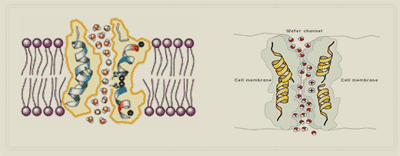 |
| An ion transport protein that generates voltage across a membrane. | electrogenic pump |
| A ______ protein is a transmembrane protein that helps a certain substance or class of closely related substances to cross the membrane. | transport protein |
| Cells will have to use active transport if they are trying to transport substances against the ________ of that substance. | concentration gradient |
| A protein appendage loosely bound to the surface of a membrane and not embedded in the lipid bilayer. | peripheral protein,  |
| ______ occurs in walled cells when the cytoplasm shrivels and the plasma membrane pulls away from the cell wall (due to the cell losing water to a hypertonic environment). | plasmolysis, 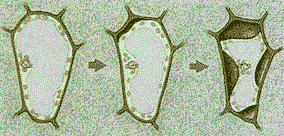 |
| A measure of the ability of a solution to cause a cell within it to gain or lose water is called _____. | tonicity |
| _______ diffusion is the spontaneous passage of molecules and ions, bound to specific carrier proteins, across a biological membrane down their concentration gradients. | Facilitated diffusion,  |
The picture below is showing _____.,  | active transport,  |
Which of the six major functions of cellular proteins is being shown below?, 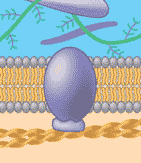 | attachment to cytoskeleton and extracellular matrix,  |
Which of the six major functions of cellular proteins is being shown below?,  | cell-cell recognition,  |
Which of the six major functions of cellular proteins is being shown below?, 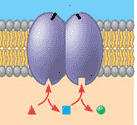 | enzymatic activity (enzymes that are involved in multistep metabolic pathways are often found near each other embedded in a membrane),  |
Which process is shown below?,  | Simple diffusion,  |
Which process is shown below?,  | facilitated diffusion (It's diffusion because the particles are travelling down the concentration gradient. It's facilitated because a channel protein is helping),  |
What type of membrane protein is shown below (be specific)?,  | gated channel protein,  |
What are the brown and green things below?,  | glycoproteins,  |
Which of the six major functions of cellular proteins is being shown below?, 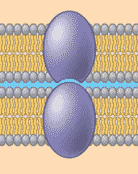 | intercellular joining (for example, tight junctions, and gap junctions,),  |
The cell on the right has undergone _____.,  | plasmolysis,  |
The proton pump below is being used to set up a(n) ________.,  | electrochemical gradient,  |
What type of endocytosis is shown below?,  | Receptor-mediated endocytosis,  |
Which of the six major functions of cellular proteins is being shown below?, 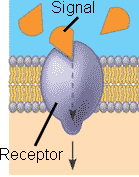 | signal transduction,  |
What is the specific name of the cell membrane protein in the picture below?,  | sodium-potassium pump (very important in nerve cells),  |
Which of the six major functions of cellular proteins is being shown below?, 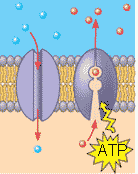 | transport,  |
Which type of transport protein is pictured below?,  | channel protein,  |
Which type of transport protein is pictured below?,  | carrier protein,  |
What type of solution was the cell on the left exposed to?,  | hypotonic,  |
What type of solution was the cell on the middle exposed to?,  | isotonic,  |
What type of solution was the cell on the right exposed to?,  | hypertonic,  |
Which process is shown below?, 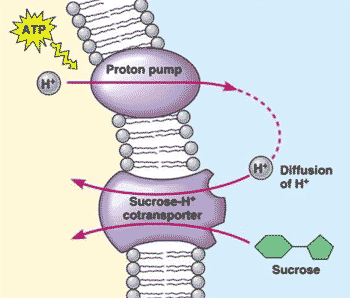 | cotransport,  |